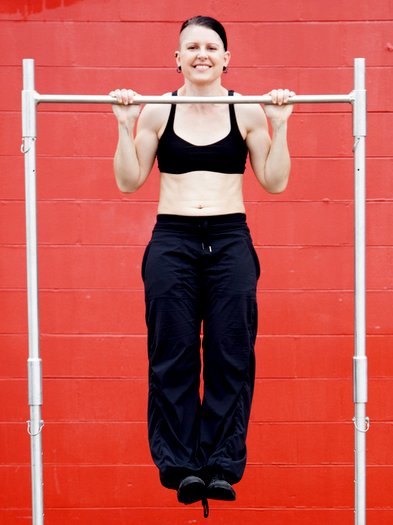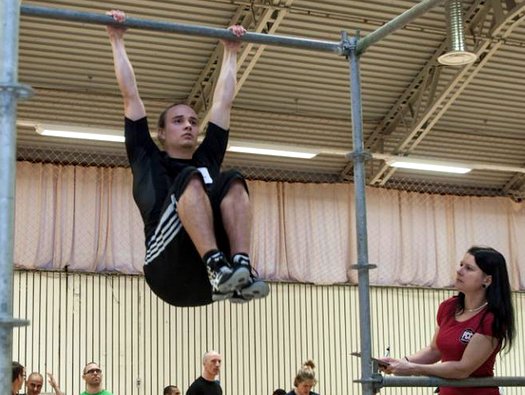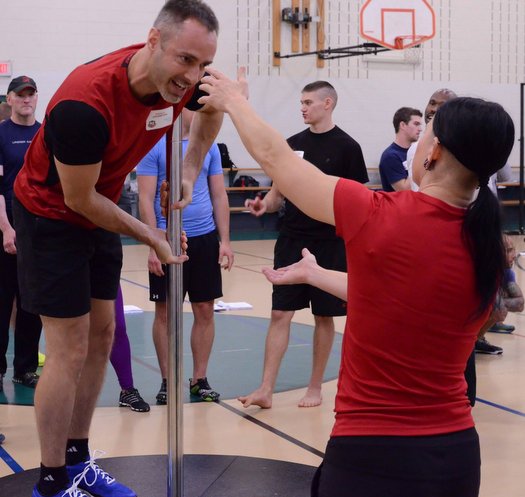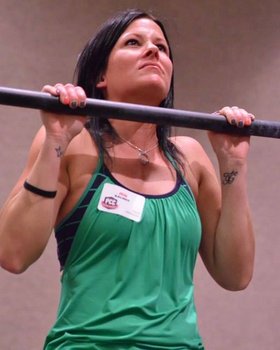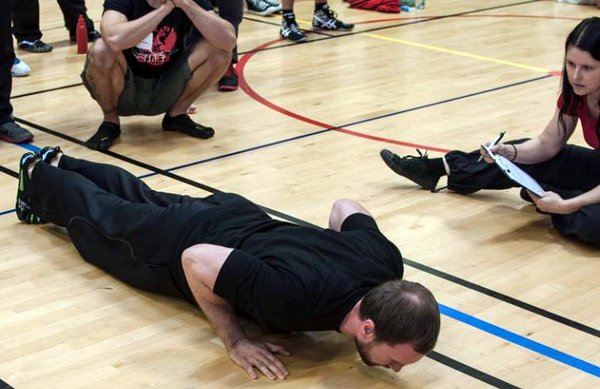
The Century Test is the climax of every Progressive Calisthenics Certification event. After three days of intense training, the Century is the only opportunity for prospective candidates to prove their mettle and earn the title of PCC Instructor.
While helping Al and Danny teach at several PCC workshops, I’ve noticed the same common issues continually come up during the Century Test. Before you think these don’t apply to you, remember I’ve actually seen many accomplished and highly athletic people make these very mistakes! Of course we make sure to point out the complete rules and standards at each workshop, but why not work to avoid these hidden perils from the beginning?
First, let’s talk about speed—you will have a total of EIGHT minutes to complete your Century Test. Somewhere along the line, a terrible rumor started about doing the test “as fast as you can.” Unfortunately, this is the opposite of how the test should be approached; the Century is not a race!
While we don’t want you to fall asleep mid-test or run out of time, we do require you to use a moderate pace that allows you to complete each rep with your best form, crisply and cleanly. We also need to be able to evaluate and count your reps in real time. If someone gets into speed demon mode, it’s very difficult to evaluate AND count each rep while making sure they are up to our standards. We shouldn’t be seeing “motion blur” around you!
Once you begin a set, you can’t stop until you have completed the required amount of reps (which will be counted by whoever is testing you—Al, Danny, or an assisting PCC instructor). For example, the first set is 40 bodyweight squats. Once that set begins, there’s no stopping until you complete all 40 reps. After a set is completed, you can take as much time (within that total of eight minutes) as you need to rest between sets—more on that later!
For many PCC attendees, an odd issue happens with the squats, but it is easily corrected. Sometimes people focus SO much on the “down” portion of the squat that they don’t always fully complete the “up” portion! Make sure you stand ALL the way UP at the end of each squat rep. Again, if this can happen to some of the most athletic and accomplished people then it can happen to anyone. If you have a training partner, ask them to keep a close eye on your full squat movement (or record a short video of yourself).
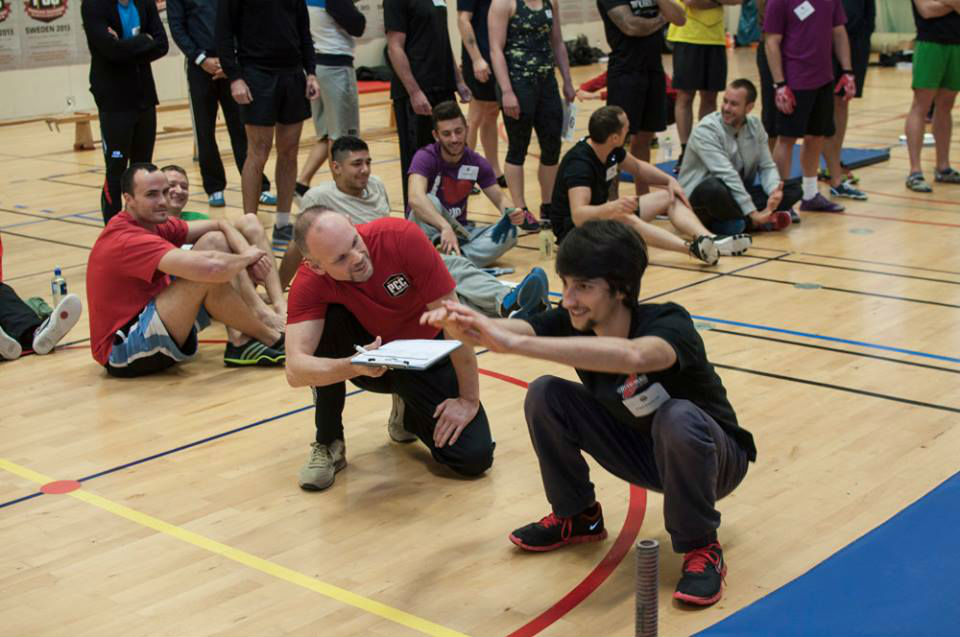
As for the lowering phase, the top of your thighs must come below parallel with the ground without any bouncing at the bottom. Some people have had issues here as well, so make sure you go all the down before you come all the way up!
Next up are push-ups, 30 reps. Men will do these from the feet, and the ladies will be doing them from the knees. (Feet must be together for men; knees together for women.) Again, be sure to come all the way up to a full lockout at the top – much like the squats, it’s easy to become preoccupied with the bottom portion of the exercise, the required depth, etc. while shortchanging the completion of the rep. Use a comfortable, moderate pace so we can see that all your reps are up to our standards.
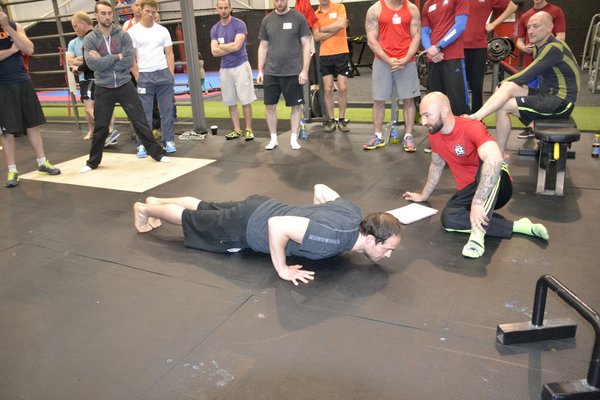
Many of the women who come to the PCC are super fit and have not done push-ups from the knees in a while—these same women often tend to have some very fashionable workout wear. This can be perilous when these high performance fabrics make our knees slide during the push-up. Suddenly our hands and knees are very far apart, and it’s against the rules to re-adjust them during the set. Make sure you have a non-slip mat below you, and/or hike up those shiny capris past your knees so they do not move on that mat!
Another issue that even very fit women will have with the knee push-up (especially if we’re used to doing push-ups from the feet) is the idea of keeping the body in a perfectly straight line from the knees to the shoulders, without bending at the hips. Have a training partner observe you, or shoot a video to watch and make sure for yourself. One cue I have used successfully with clients is to have them practice by starting in a “straight arm plank” position, then while keeping the trunk straight, drop down to the knees to find the proper alignment to begin a knee push-up.
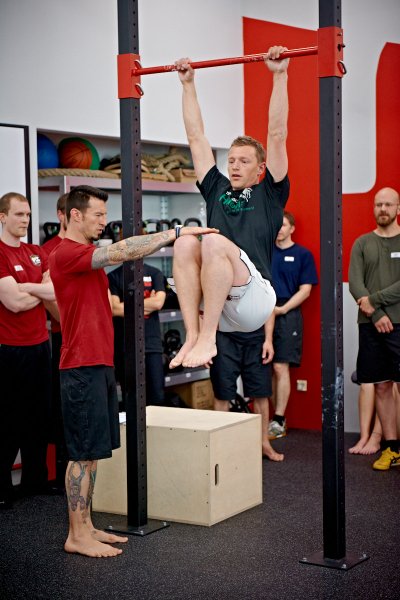
Hanging knee raises are a real equalizer! Like squats, they’re tested the same for men and women. You must not swing or use momentum to make these reps, and you must hang onto the bar for the entire duration of the set. Make sure to grip the bar tightly while squeezing your shoulders down and back (basically, don’t hang like a limp noodle!) Imagine trying to bend the bar in half to intensify this feeling. Make sure to practice this at home!
Don’t underestimate a set of 20 knee raises. Bringing your knees above your waist takes a surprising amount of abdominal strength when you don’t use any momentum. When your feet come back down (also under control), I’ve found that aiming to put them just below (or even slightly in front of) your body is a great way to prevent momentum. People have found themselves in big momentum-trouble when they’ve extended their feet behind them on the “down” portion of the knee raises, because they start swinging back and picking up momentum. It almost becomes a mini-kip. Control is the name of the game with knee raises!
Finally we have the pull-ups, which are often the most challenging (and potentially heartbreaking) part of Century Test. Sometimes someone with plenty of time to spare just wants to get the test done and he or she does not give themselves adequate rest between the hanging knee raises and the pull-ups. I’ve seen very strong (but reasonably fatigued from 3 days of fun and intensive PCC work) people fail the test at the workshop because they couldn’t finish those last 1-3 pull-ups. An extra 30 seconds to 1 minute rest time between sets could have meant the difference between passing at the PCC or having to go home, regroup, train and submit a test video. It’s moments like these that we all wish for an “undo” or “rewind” button on life! Don’t underestimate the adrenaline rush of “test time”! Remember, it is not a race; you have 8 full minutes, so use it!
For the pull-ups, men will be doing 10 dead hang pull ups from a pull up bar with their choice of underhand or overhand grip. (If the bar is too high, and/or your hands are somehow shredded because you were inspired to overdo it a bit on the previous days, do not hesitate to ask us for a step stool!) Women will be performing 10 “Aussie” pull-ups (down under the bar—also known as bodyweight rows) from a waist-height bar. Again, I can’t encourage the ladies enough to experiment with these bodyweight rows. When practicing for the PCC, find a bar that’s the right height for you, and make sure that your body is positioned in such a way that you’re able to pull yourself up to the bar without having your feet slide—experiment with a mat, or a good shoe choice, etc. Pull yourself up close to the bar at the top of each rep, stay engaged (think plank) without having your body bow up or slump down.
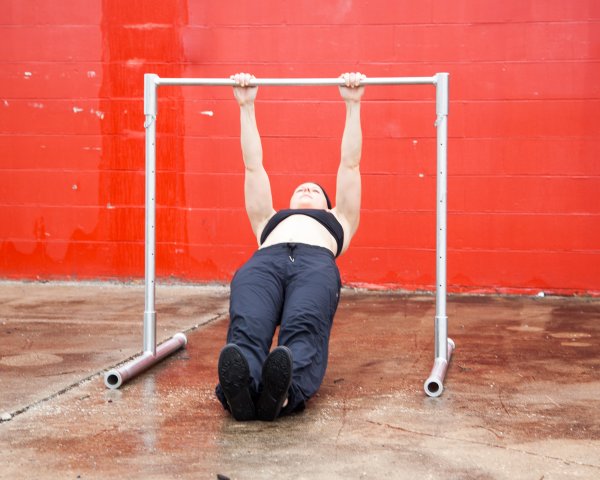
Men, make sure that you are doing full pull-up reps, as half reps won’t count and can be costly in terms of fatigue! A SLIGHT kink in the elbows at the bottom of the rep is technically allowed, but make sure to have someone check you and video yourself to make sure that you aren’t slipping into doing half-reps. And, no kipping or momentum allowed!
I hope that these details have been helpful, and please feel free to ask questions here and always at the workshop. We really do want everyone to pass if they are truly ready and able to represent the PCC as a certified instructor, while helping their students/clients improve their fitness and quality of life.
Hope to see you at a future PCC Workshop!
Adrienne
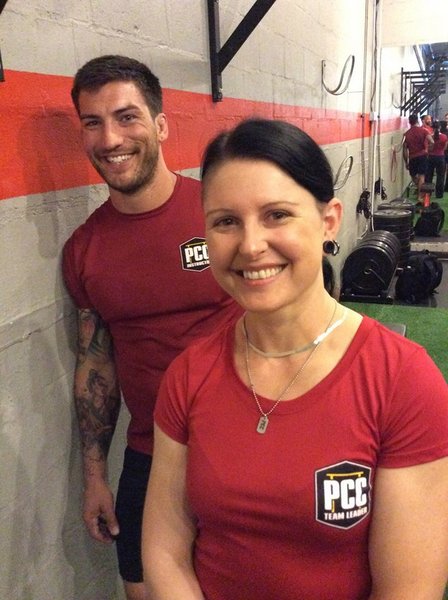
***
About Adrienne Harvey, Senior PCC Instructor, RKC-II, CK-FMS, Primal Move Nat’l Instructor: Originally RKC Certified in 2010, and RKC Level 2 certified in 2011, kettlebell and bodyweight training have been crucial in Adrienne’s personal quest for fitness. A core member of the PCC team, Adrienne loves sharing her knowledge with small groups and individuals. She also loves to develop recipes and workout programs to further support performance, body composition, and of course—FUN. Go to http://www.giryagirl.com for more information about Adrienne!
